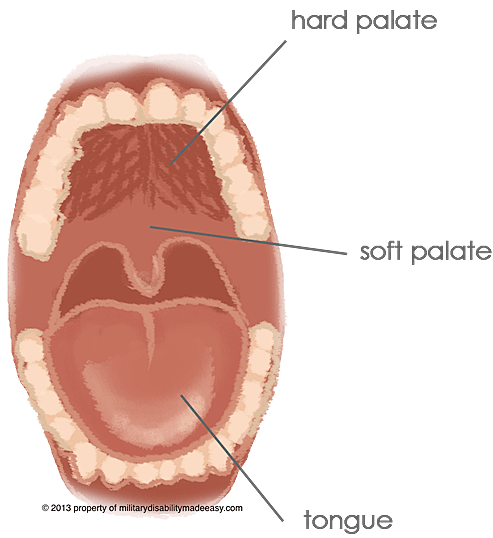The Mouth and Teeth
Topics:
Mouth and Teeth Overview
Mouth and Teeth Ratings
Mouth and Teeth Overview
The VA awards disability compensation for each Mouth and Teeth condition that is service-connected. The DoD will also rate service-connected conditions as long as they also make the service member Unfit for Duty. For Reservists, the condition must have occurred in or resulted from an injury in the Line of Duty to qualify.

Dental conditions of the Mouth and Teeth deal primarily with the jaws, the jaw joint, the palates, and the teeth. For other conditions of the Mouth, see the Digestive System page.
The VASRD offers rating options for dental conditions of the Mouth and Teeth based primarily on how well the jaws and teeth are able to open the mouth and chew food.
To honor the Pyramiding Principle, only a single rating can be given for multiple dental conditions of the Mouth and Teeth unless the symptoms of the conditions can be clearly separated. In most cases, multiple dental conditions of the Mouth and Teeth will be rated using all of the symptoms combined together, and the VA will choose the single code they feel best covers the overall Mouth and Teeth disability (see The Mouth and Teeth Ratings page for details and any exceptions).
For muscle or nerve conditions that affect the movement of the mouth, see the Facial Muscles and the Cranial Nerves pages.
Return to Top
Mouth and Teeth Ratings
The VASRD offers ratings for the following dental conditions of the Mouth and Teeth:
- Conditions of the Mandible (lower jaw bone)
- Conditions of the Maxilla (upper jaw bone)
- Conditions of the Temporomandibular Joint (jaw joint) and Condyloid Process
- Conditions of the Palates
- Conditions of the Teeth
- Cancer and Tumors of the Mouth and Teeth
If a dental condition of the Mouth and Teeth is not directly listed on the Mouth and Teeth Ratings page, it is rated under the code that best describes it or its dominant symptom.
Return to Top
FAQs
How will the VA rate my dental condition?
The VA uses the rules of the VASRD to rate dental conditions based on how they affect the ability to chew food. Check out our Mouth and Teeth Ratings page for the exact codes and ratings.
Can I get VA Disability for gum disease?
Gum disease alone does not qualify for a rating. However, if the gum disease is so severe that it leads to the loss of teeth, then that could qualify.
How will my tooth condition be rated for military disability?
Teeth conditions can only be rated if they result in the significant loss of teeth that cannot be replaced by false teeth.
How do I apply to receive my ratings?
If you are still in the military, then you can request your military physician to refer you to the MEB and start the IDES process. If you are already a veteran, you can submit a VA Disability Claim along with evidence of service-connection and all medical records regarding the conditions on the claim.
If my claim is approved, what benefits will I receive?
If you are rated 20% or less from the DoD, then you will receive a single separation payment. If you are rated 30% or more, you will receive full retirement benefits. From the VA, you will receive a monthly payment as well as full medical care from the VA for the qualifying conditions.
How long does it take to receive my disability benefits?
Brand new claims usually take 3-6 months to process. Once processed, you will start receiving payments in 1-3 months.
How are the rating percentages assigned to my conditions?
The rules of the VA's Schedule for Rating Disabilities (VASRD) are used to assign rating percentages to conditions. The VASRD gives rating rules for conditions based on their symptoms, treatment options, and the resulting level of disability they cause.
My conditions have worsened. How do I increase my rating percentages?
If your conditions have worsened since you last applied and now qualify for a higher rating, you can submit a new claim, checking the box for an increased evaluation.



